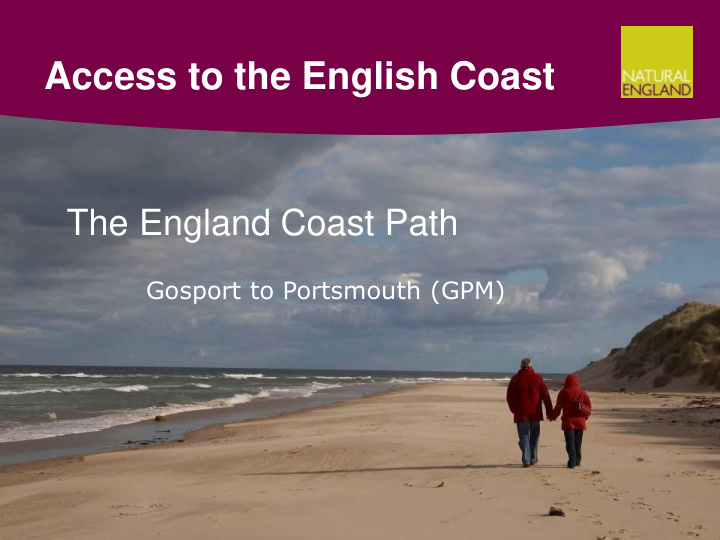



Access to the English Coast The England Coast Path Gosport to Portsmouth (GPM)
What will the coast path bring… • Secure, continuous, clearly way-marked, well managed route • National Trail brand and funding • Tourists with spending money, International draw • Reconnecting people with their local coast • New management of some sites/routes • A unique and straightforward way to deal with coastal change (roll back) • The longest continuous coast path in the world
So what is the England Coast Path? • The Marine and Coastal Access Act 2009, establishes the coastal access duty - to create; • a long-distance walking route around the English coast, and • the coastal margin , land beside it, which should be accessible to the public on foot. • In discharging this duty we follow statutory guidance – the Coastal Access Scheme . • Sets out an approach and ensures that a balance is struck between the interests of those who own the land and the public in having new access rights over the land. • It also enables us to respond to coastal change (‘ roll back’) and ensures protection of the natural environment.
Where we are delivering - locally
www.naturalengland.org.uk
Principles of alignment • First we align the route of the trail in consultation with owners and occupiers of affected land, identifying the least restrictive option necessary to achieve suitable outcome – Adopt an existing PRoW or promoted route – Adopt a permissive or de-facto walked line – Create a fresh ‘line’ • Everything seaward of that line becomes spreading room, bar ‘excepted land’
Excepted land categories Excepted in full • buildings, their curtilage, parks and gardens: • land used for the purposes of a railway, racecourse or aerodrome; • land used for statutory undertaking, although not flood defences; • school playing field or associated land; • land in use for mineral extraction; • MOD land subject to byelaw; and • land which is, or forms part of, a highway. Excepted, but legislation allows for a route (only) to be proposed: • arable land; • golf course; • a regulated caravan or camping site; and • burial grounds.
Roll back – repositioning the trail due to coastal processes
Balancing public & private interests Public interest Private interest • Proximity of the trail to • Operational needs the sea • Income • Views of the sea from the trail • Privacy • Safety and convenience • Changes of use • Continuity of the trail • Enjoyment and protection of the natural environment • Responsiveness to coastal change – ‘ roll back ’
Access and Sensitive Features Appraisal • Developed an Access and Sensitive Features Appraisal (ASFA), incorporates Habs Regs Assessment (HRA), extended to SSSI and EPS • Ensures consistency of approach and compliance with all legal requirements • Iterative approach to developing proposals… • identifying sensitive features and locations e.g. roost sites • Identifying existing use (patterns/frequency) and management on sites • identify avoidance measures (trail location) • mitigation and management as necessary and to the level that’s necessary – least restrictive option • ‘Access & Nature Conservation Review Panel’ to give advice for controversial cases
Some available management measures… • Least Restrictive Trail location • Signing, waymarks and guide posts • Mown surfaces • Interpretation boards • Natural barriers – vegetation, screening inc. temporary fencing • Guide fencing or permanent fencing • Direction to restrict access, temporary, seasonal, area based e.g. dogs on leads between dates Most Restrictive • Direction to exclude access, temporary or permanent, area based
Management and Maintenance • Natural England will work on the proposals with the Access Authority and other key stakeholders. – Will have MOA in place with Access Authorities asap. – Can delegate to NPA or other body – offer/ask • Once the ECP has been established, responsibility for its maintenance sits with the Access Authority who will be required to: – Deliver a well maintained trail – Undertake a survey not less than every 3 years and report on the condition of the route and any issues over its alignment. – Fulfil specific grant conditions for reporting and claiming. – Fulfil the National Trail and ECP quality standards. – Demonstrate match funding at a minimum agreed ratio (local contribution: NE contribution).
Reduced liability and future management • Areas of land covered by the trail and/or spreading room attract reduced occupier liability • Landowner cannot be sued for accidents involving natural or man made features on land covered by coastal access rights • The Access Authority is responsible for the ongoing management of the England Coast Path National Trail. – National Trails funding available to assist.
Developing the Coast Path
Recommend
More recommend